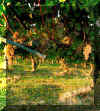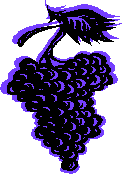|


Traditional cascks

Stainless steel vats.

Vineyard

Grape

Gavi's Cellars Map
|
...moon
and wine have
an ethereally agreement: the wine gives to the moon its perfume, its
sublime flagrancy and its softly rough, sweet smell. In change the moon
gives to the wine its help to have the best meteorological condition to
rise the flower and the taste of this nectar and elixir of life.
It is well known that wine sleeps for a long time in barrel to elaborate all
its marvelous components and become what nature gives us as a marvelous essence
of love, creativity, fantasy and happiness.
When wine wakes up and needs to be poured into to the bottles, it needs a special
weather conditions, and that's what the moon offers to the wine. A very
special circumstances, as tide at sea, is created by the moon for this
special event. It is like you can feel the air becoming lighter,
all around becomes quite and soft, if you enter into the cellar and you
are closing in, near the peasant during the ceremony of pouring the wine from the barrel
into the bottles, you enter an atmosphere which satisfy all your
sense. It is like you get the sensation that an entirely year goes by; the time
necessary from fruit to become wine, the weather, the seasons, day per days,
are passing by again. |
|

|
In
this landscape of rows of vines stretching as far as the eye can see,
men's lives have for centuries followed the rhythm of the life cycle of
the grape. The tenacity and sacrifice of individuals have also played
their role in the making of the vineyards of Gavi.
Only a few regions in the world are blessed by nature with the
production of noble grapes which make truly great wines.
The land of Gavi is one of these favorite areas: strong in its
viticultural vocation even though not jet widely recognized. These few
hundred hectares of hills have a mild, sunny climate and are freshened
by the sea breezes of nearby Liguria.
Seeing the Gavi's area, its vines and taste its extraordinary wine; hear to the
history and traditions of the viti-vinicultural microcosm of Gavi, an
old saying comes to mind: "it is difficult to find a good wine, but
it is even more difficult to make one."
To produce a great wine, one needs above all a great vineyard - not
as regards its size but meaning a patch of ground which, with its mix of
soil, exposure, microclimate and the way it is husbanded, is able to
confer on the wine it produces those exceptional and unique
organoleptic characteristics and which are, however, greatly superior to
the average quality of the same wine produced in similar zones. |
|

|
|
A document dated 3 June 972, and
now conserved in the State Archives in Genoa, states that Teodolfo
Bishop of Genoa rented to Pietro and Andrea, freemen of Gavi,
church-owned vineyards and chestnut woods to be found at Gavi and at
Meirana, a place which even today still works its vineyards, a few
kilometers from Gavi. This is maybe the only document witnessing the old
tradition of the viti-vinicultural's world of Gavi, but it doesn't
mean that they were the only vineyards existing at that time, for sure
not.
We know well that the wine has origins that goes back to ancient times,
as can be seen from many archaeological relics and from reading the
oldest text on the history of man, but it is certain that the greatest
impulse to its diffusion came from the Romans.
The origin of vine-growing in Gavi is not dissimilar to that of the
other zones in the southern part of Piedmont, and the Cortese vine is
considered by most expert to be native to the upper Monferrato,
Asti area, where it has always been cultivated. It favours exposure to
sunlight, especially the mid-day sun. It is grown and prospers in calcareous
as well as in clayey and mixed soil, and even in tufaceous soil. It is
quite resistant to winter frost and generally it is not badly damaged by
cryptogams.
But it is not until the 18th century that we find, in the works of Count
Nuvolone, any mention or description of a species of vine called Cortese |
|

|
The moon
feet to wine as wine feet to Gavi. The weather conditions and geographic
conformation of this area, as said, allows a perfect union for the
production of valuable-esteemed grapes.
Geographically, Gavi is located in southern Piedmont, practically on the
border with Liguria, and thus near the mountains of the Ligurian Apennines.
Piedmonte, as it means in Italian language, it can be considered as
region "at the food of mountains" as well as other
regions like: Lombardy, Veneto, Trentino Alto Adige, Friuli Venezia
Giulia and Valle d'Aosta.
In these regions, we find a climate defined as the "piedmont
type", characterized by rigid winters, hot summers, and rather mild
springs and autumns, more or less rainy.
These are the classic feature of the "fruity wine belt,"
typical of those regions which are above the 44th parallel, where the
wines produced - with several exceptions - have an alcoholic content
which is not very high, but are characterized by a complex, dinstinct
bouquet.
Below the 44th paralel, the wines are known as the "alcoholic
content belt," characterized by very hot summers and rather mild
winters. |
The history,
maps, events and infos of Gavi and Alto Monferrato: the producers of wine, photos of the wineyards,
bottled wines and the
addresses of the wineries, monuments etcetera...click the sites here down
below.
|